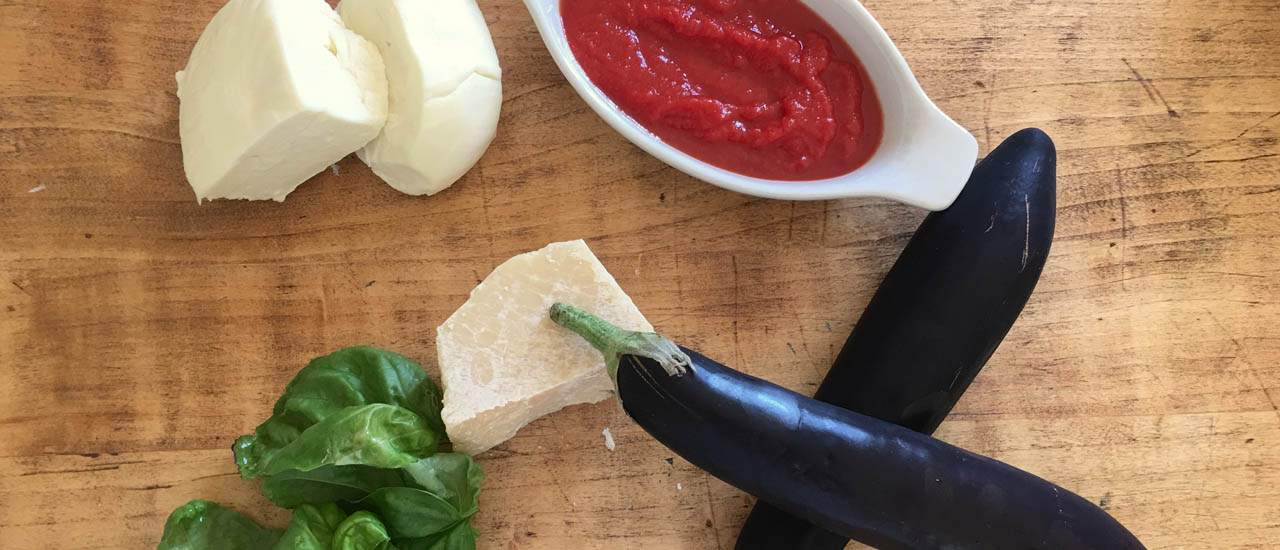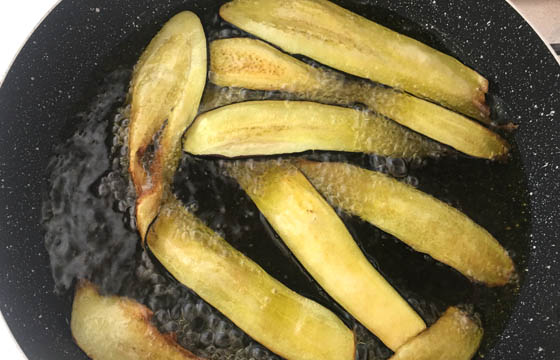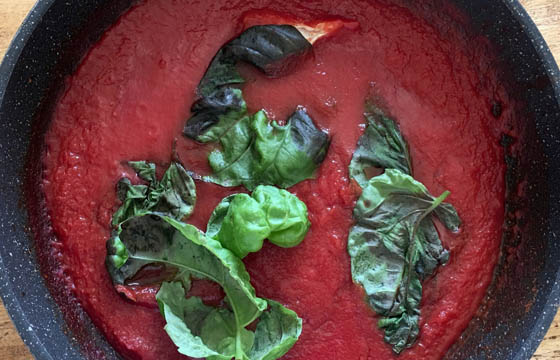Ingredients
 2 kg of long aubergines
2 kg of long aubergines 500 g of tomato purée
500 g of tomato purée 1 clove of garlic
1 clove of garlic Extra virgin olive oil to taste
Extra virgin olive oil to taste Grated Parmesan cheese to taste
Grated Parmesan cheese to taste 500 g of mozzarella or provola cheese
500 g of mozzarella or provola cheese Fresh basil to taste
Fresh basil to taste

The provenance of Aubergine Parmigiana is uncertain and is still disputed by various regions of Italy. According to some, "Parmigiana" derives from the Sicilian word parmiciana, in turn coming from the Latin parma ("shield"), a term used to indicate slatted shutters, which recall the arrangement of the aubergine slices in this recipe. The name of the recipe also suggests an attribution to the city of Parma. But, not to be partial to anyone, let’s talk about the Neapolitan version of this dish. Another glory of Neapolitan cuisine is the Parmigiana. Few basic and well-matched flavours and here is a delicious dish, tasty and appetizing, well suited to the summer. Jeanne Caròla Francesconi, writer and expert in Neapolitan cuisine, argues that the origins of the recipe date back to two centuries ago, and identifies them in the works of Cavalcanti earlier and Vincenzo Corrado, later. But, the rivalry is not confined to the different regions of Italy. The "war" is above all an internal one, between various different families of Campania and Naples. In the Cilento, the coastal area of Salerno, for instance, aubergines are first “golden fried” – i.e. dipped in flour and eggs, fried and then laid out in the tray in the classic way. In Naples, they are fried directly, and then some dress them with meat sauce, some with fresh tomato sauce, some bake them in the oven, some over the fire or in bain-marie. One thing everyone certainly agrees on: few things are as good as Aubergine Parmigiana. Not only is it good straight out of the oven, hot and fragrant with its tomato flavour and the unmistakable aroma of the aubergines, but even better on Sunday evening, when all abiding Neapolitan families dine with some leftovers from the large lunch, if they are still feeling peckish. Some pasta dressed with coarsely cut pieces of Parmigiana to find the strength to start another week.
 2 kg of long aubergines
2 kg of long aubergines 500 g of tomato purée
500 g of tomato purée 1 clove of garlic
1 clove of garlic Extra virgin olive oil to taste
Extra virgin olive oil to taste Grated Parmesan cheese to taste
Grated Parmesan cheese to taste 500 g of mozzarella or provola cheese
500 g of mozzarella or provola cheese Fresh basil to taste
Fresh basil to taste

The most important and perilous step is certainly the frying phase. First cut the aubergines - with oblique slices (in the shape of the flute’s mouthpiece), if you prefer a more balanced proportion between skin and pulp, or long slices, if you want less skin. The thickness should be approximately 4 mm. Look at the aubergine pulp: if it is full of very small seeds you will need to let them rest for a few hours with a bit of salt, so that they lose their bitter aftertaste. If, however, they have few or no seeds, you can fry them directly.

In a very large frying pan, heat up sufficient oil. The more oil there is, the less it will be absorbed by the frying process. When the oil is very hot, fry the aubergines a few at a time. Use olive oil to fry, because aubergines tend to absorb a lot of oil. Drain them when they have turned a golden colour (it will take several minutes) and lay them out in a pasta drainer placed over a bowl. Fry until you finish the aubergines. When you're done, fill a cooking pot with water and place it in the drainer to make sure that most of the frying oil comes out.

Prepare the sauce. There are several schools of thought in this regard. Cook the tomato of choice briefly with a clove of garlic and some basil.

Place the first layer of aubergines in a tray, preferably non-stick. A common mistake is to start with a layer of sauce directly in contact with the bottom of the tray. This operation is incorrect because the sauce will burn. So, start directly with the aubergines, which, since they contain oil, will not stick to the tray.

Continue with salt, tomato, Parmesan cheese, mozzarella and some basil leaves. Cover with the aubergines and repeat the operation until your ingredients finish. The last layer will only be dressed with tomato and Parmesan cheese.

Bake in the oven at 190 °C for about 40 minutes. Let it rest for at least an hour before serving it.